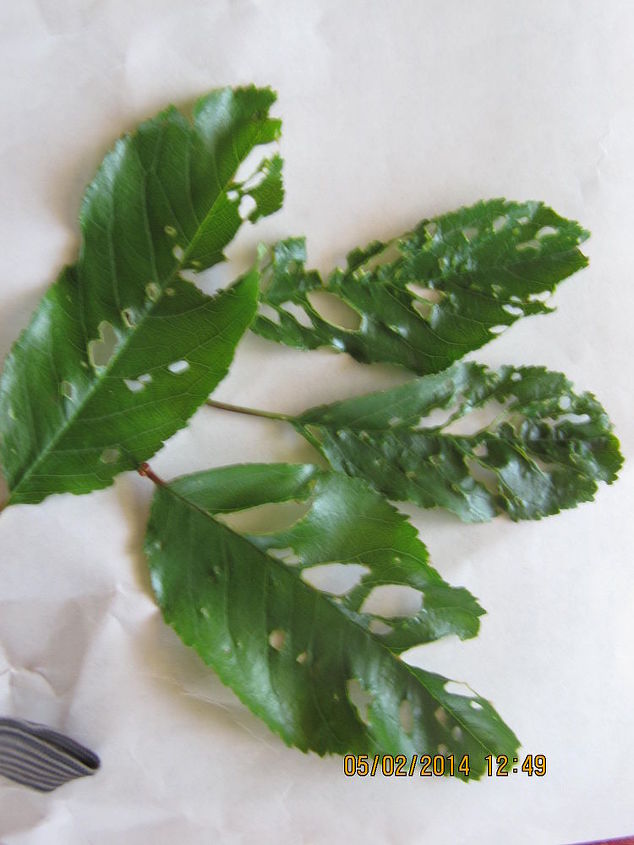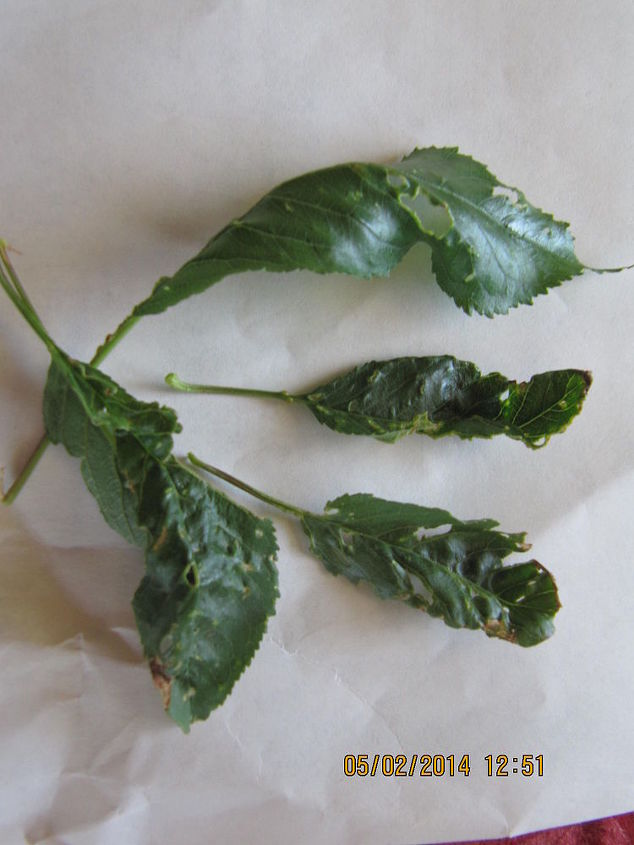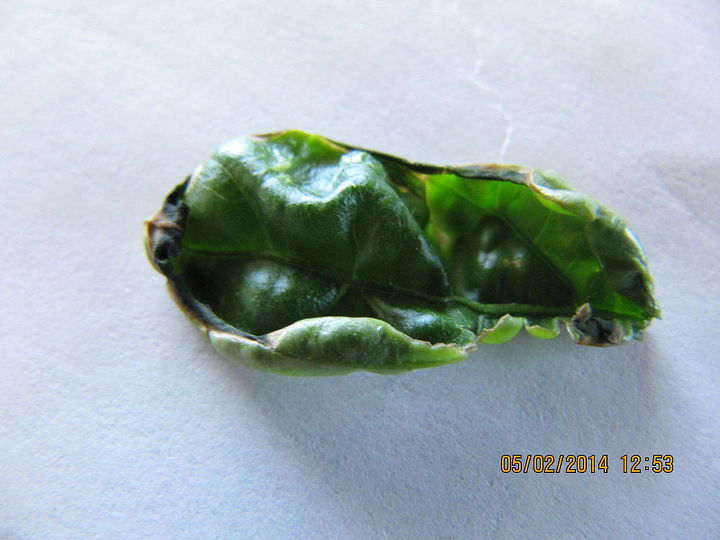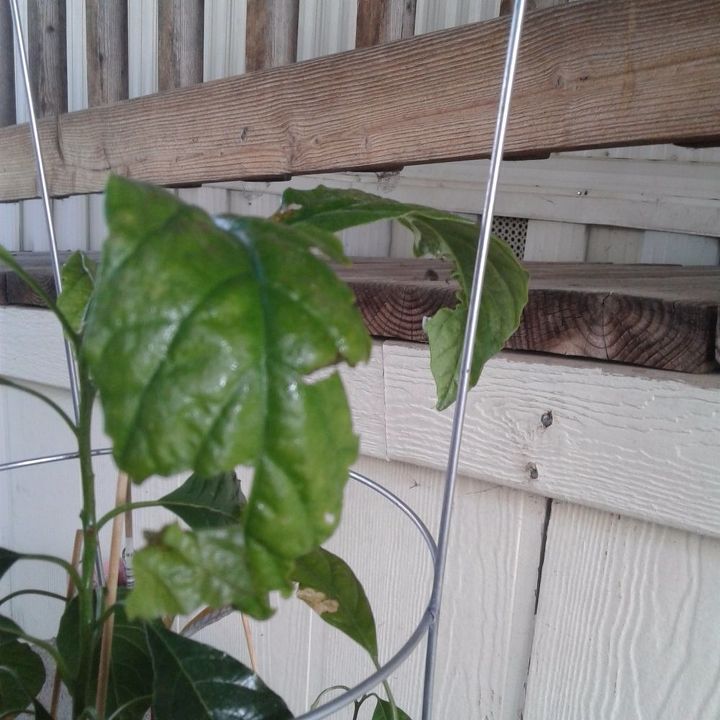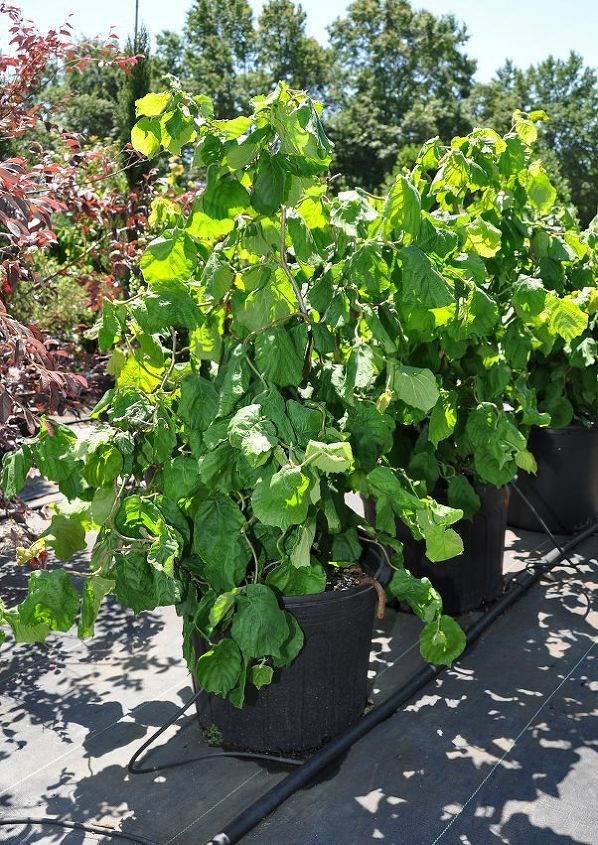Help. Somethings eating my plants.

-
I have read, where you mix dawn dish washing liquid in a sprayer and spray. Haven't tried it.
 Ri-Lee
on May 02, 2014
Helpful Reply
Ri-Lee
on May 02, 2014
Helpful Reply -
-
Ms. Barnett, here's some mixtures, maybe one of this will work, for whatever bug is eating your leaves. I had a fly type bug eating my peach tree leaves, used the tea mixture, and seem it worked or killed the bug. Bug would land on leave and like a lawn mower would cut the leave off, in less than a second. FAST! and fly off. 35 Pest and Disease Remedies Turn to your pantry and medicine cabinet for simple solutions to common garden problems I’ve found that awareness and a quick response are two of the best allies against garden foes. By knowing my plants, as well as their pest sand diseases, I can be proactive in combatting garden ailments. When problems do arise, I turn to the most benign and natural forms of control, like hand-picking invaders,setting up barriers, or trimming problem areas off plants. If these interventions fail, I apply my easy homemade potions to treat my gardens, keeping in mind the welfare of the soil and the dwellers who share the earth with me. Anyone walking into my potting area is liable to find four or five mixtures of fertilizer brews and oddball pest blends fermenting in tubs, along with a strange collection of tools and utensils. It is not the aftermath of some cataclysmic disaster; it is my laboratory, my living library, and the makings for a healthy garden. For more articles on this topic,check out our section on pests and diseases. Before you begin... My friend and garden assistant, Peggy, tells me that of all the yards she helps tend, mine is the healthiest (although it is not necessarily the tidiest). I credit that health to myriad factors. Every speck of my growing areas (even potted plants) is covered with rich organic matter like aged compost, worm castings, or shredded leaves. I grow a diverse array of plants—bulbs, annuals,perennials, shrubs, and trees—to create a well-integrated yet multifaceted garden that attracts scores of beneficial inhabitants such as insects, lizards,toads, frogs, snakes, and birds. Before adding any plant to my garden, I make sure that it is healthy and thriving and is planted in an area that suits its needs. On the occasion that I need to treat a plant for a pest or disease problem, I follow these simple guidelines: • Test homemade sprays on a small portion of the plant before applying it to the entire surface.Monitor the plant’s response for a couple of days to check for burning. •Add a few drops of liquid soap to homemade foliar sprays. It helps to emulsify, or blend together, the other ingredients. It also acts as a surfactant, or wetting agent, which will ensure uniform coverage on leaf surfaces or insect bodies (causing desiccation and death). Always use soap(never detergent) so as not to burn plants; good choices are Dr. Bronner’s,Fels Naptha, or any pure castile soap, all of which can be found in health-food stores. •Apply sprays early in the morning and never when the temperature is above 85°F to prevent sunburned leaves. •Wear rubber gloves when using any sprays containing peppers, alcohol,citrus concentrates, mint oils, or anything else that could irritate your skin.And when spraying outdoors in breezy conditions, wear eye and nose protection. •Examine your plants thoroughly before apply- ing sprays to make sure that you aren’t spraying any spiders or beetles that might be your allies in the fight against pests. Animal pests Make your own deer repellent with eggs, beef bouillon, water, and liquid soap. Deterrents for deer Most gardeners agree that a strong, tall fence (preferably electric), tilted outward at a 45-degree angle, or two fences about 5 feet apart are the longest-lasting solutions to a deer problem. But if a fence isn’t in your budget or doesn’t fit in with your garden design, here are some alternatives: •Dangle strips of Mylar or compact discs from tree branches to alarm deer. • Poke a hole with a needle and fishing line through tiny, scented bars of soap(wrappers on), and hang several on each shrub or tree in your garden. ASmithsonian Institution research team found Lifebuoy soap to be the best. • Make your own deer repellent. Rotten eggs and beef bouillon are ingredientsin many commercial deer repellents. Break 1 dozen eggs into a bucket, add 4cubes of beef bouillon, and fill the bucket with water. Cover it with a lid,and let the mixture sit until it stinks. Add 2 tablespoons of liquid soap per gallon of liquid, and pour the mixture into a spray bottle. Then hold your nose and spray the plants. Do not spray it directly on plants that you will consume;instead, spray it around them to create an invisible barrier. For edibles, use“garlic soup” (see “Diseases”), which I also apply to thwart plant diseases. What does deer damage look like? Watch a video... Sweet gum pods protect plants from rabbits. Simple ways to keep rabbits at bay The heartbreak caused by a mowed-down sunflower, hosta, tulip, or whatever happened to be on the resident rabbit’s menu that day is something no gardener should have to bear. Here are a few tricks I use to divert those rascally rabbits: •Shake baby powder or flour on young seedlings and garlic powder on mature plants to make them unpalatable. • Surround prized bushes or herbaceous plants with a thick planting of garlic and wormwood to offend rabbits’ discriminating sense of smell. • Encircle plants with small branches of spiny holly leaves or the large,dried, prickly seed vessels of the sweet gum tree (Liquidambar styraciflua).The evergreen holly branches can be collected and used anytime. Gather the sweet gum pods in the fall, and store them in a dry area. In early spring,place them firmly in the soil surrounding the plants. Moles be gone To discourage moles, sink a line of glass bottles into the soil with about 1inch of neck exposed. The whistling sound of wind blowing across the bottle tops disrupts moles’ sensitive hearing and hinders their ability to find prey.Poking several noisy toy windmills into the soil will also disturb moles, as the vibrations will drive them away. Moles dislike garlic, so try dropping some crushed cloves into the run. You can alsorepel them with a castor-oil concoction. Mix 8 tablespoons of castor oil and 1tablespoon of liquid soap in 1 gallon of water. Dig down into one of the critter’s runs, and pour the mixture inside. Insect pests Grapefruit rinds lure slugs. Barriers and baits for slugs and snails Slugs and snails are responsible for wiping out many a gardener’s dreams. I create barriers around prized plants to protect them from annihilation. Copper strips produce a shock to snails and slugs trying to cross them. Wrap inexpensive, thin copper, found in craft stores, around pots, plants, and trees to create a protective barrier. Pine needles, coffee grounds, crushed eggshells, or diatomaceous earth (fossilized,silica-shell remains of prehistoric diatoms that desiccate insect bodies)provide a scratchy barrier and should be reapplied after a rain. Always purchase natural diatomaceous earth because swimming-pool grade contain scrystalline silica, a respiratory hazard. •I also use several bait techniques to catch slugs and snails; then I scrape thecreatures into soapy water in the morning. Here are some ways to lure them: • Set out fresh grapefruit and melon rinds each evening in a moist, shady are aplagued by slugs and snails. • Lay empty flowerpots or milk cartons on their sides in a shady area. • Water a small portion of your yard in the evening, and put down a small,wooden board that is elevated slightly on a rock. The slugs and snails will congregate on the board’s underside. Blendedl arkspur or delphinium leaves make an effective spray against Japanese beetles. Japanese beetle busters Like slugs and snails, Japanese beetles have plagued gardeners for years. One way to stop them in their tracks is to suck them up with a small, hand held vacuum. Another way is to throw a handful of larkspur or delphinium leaves into a blender, add the blend to 1 gallon of water, and spray the mixture onto plants being attacked by Japanese beetles. The deadly alkaloids (deliosine and delsoline) in the leaves will zap the beetles. Some gardeners have had success deterring Japanese beetles by planting a ring of garlic and chives around the affected plants, while others bounce those bugs into a bucket of warm, soapy water with a long-handled spatula or spoon. It is a natural defense for a bug to drop to the ground, so the Japanese beetles will fall straight into their sudsy demise. Try to catch them in the early morning when they’re still a little sluggish. Knock the beetles into a bucket of soapy water. Red-pepper powder repels pesky critters I have been using red-pepper powder for years on everything from cucumber beetles and spittle bugs to leaf hoppers and cabbage loopers. Now there is scientific backing for this treatment: Entomologist Geoff Zehnder of Auburn University in Alabama credits McCormick red-pepper powder for protecting cabbages better than any standard chemical insecticide. Mix2 tablespoons of red-pepper powder and 6 drops of liquid soap in 1 gallon of water. Let the mixture sit overnight, and stir thoroughly. Pour the mixture into a spray bottle, shake well, and spray weekly on the tops and bottoms oft he leaves. This will protect plants, especially members of the cabbage family(including broccoli, cauliflower, kale, and brussels sprouts), from destructive insects. Adhesive tape lifts small insects from plant leaves. Tricks for removing aphids, mites, and other small insects Scientists at Texas A&M University estimate that up to 90 percent of problems with aphids, mites, and spittle bug nymphs can be cured by dislodging them with a strong blast of water. You can also use adhesive tape to remove aphids and other small insects from plant leaves. Simply wrap a long piece of tape around your fingers (sticky side out), and blot off the bugs. For aphids in particular, set a yellow dish filled with soapy water near the plant.Aphids are drawn to the color yellow. For spider mites that persist despite a daily spray of plain water, use a buttermilk spray developed by scientists at Purdue University. Combine 1/4 cup of buttermilk and 2 cups of wheat flour in2-1/2 gallons of water. Pour the mixture into a spray bottle, shake the ingredients thoroughly, and spray it on your plants. Crushed strong-scented herbs make a tea that repels many insects. An herbal brew to combat trouble some creepy crawlers Basil and especially potently scented herbs- such as lavender, rosemary, tansy,southern wood, rue, mint, wormwood, or sage-help fight harmful leaf hoppers,aphids, cabbage loopers, mites, cucumber beetles, and many other creepy crawlers. Simply gather a handful of fresh basil leaves and stems and any other herb trimmings you have on hand, crush them slightly, and stuff them into a mesh produce sack, if you have one. Put the sack (or the loose herbs) into a bucket or a large glass jar that is at least 1/2 gallon in size, and fill with water. Cover the container, and set it in the sun to brew for a few days.Remove the sack, or strain the solids from the mixture. Store the liquid in a covered container in a cool, dark area until it's needed as an insecticide.When you're ready to do battle, pour the herbal brew into a spray bottle, add1/8 teaspoon of liquid soap, and shake well before spraying. Diseases Chamomile tea works against plant fungus and mildew. Chamomile tea is a cure-all for fungal diseases It’s a little-known fact that chamomile tea has antibacterial and fungicidal properties that will aid plants suffering from fungus and mildew. I often make a simple brew for my sickly plants. Place 16 chamomile tea bags (or 2 cups of dried chamomile flowers) in 2 quarts of water, and simmer for 20 minutes. Turnoff the heat, and allow the tea bags to steep for several hours. Strain, if using dried flowers. Use the tea to irrigate tender seedlings (from the bottom)to prevent damping off, or use as a foliar spray to battle diseases on plants.Because I never let anything go to waste, I also add leftover tea and used teabags to my watering can. A tonic for black spot and powdery mildew on roses Roses, while beautiful, are often plagued with black spot or powdery mildew. I mix these ingredients into a tonic, which I spray on my roses: 2 teaspoons of baking soda and 1/2 teaspoon of liquid soap or Murphy's oil soap in 2 quarts of water. The tonic protects the roses for months. Garlic helps thwart noxious diseases For plants with a fungal, viral, or bacterial disease, cook up a batch of what I call "garlic soup." Purée two cloves of garlic in a blender for a minute. Slowly add 1 quart of water, and continue blending for about six minutes. Strain the mixture, and add 1/8 teaspoon of liquid soap. Pour the liquid into a storage container and cover tightly. When you're ready to take action, mix 1 part garlic soup with 10 parts water into a spray bottle and apply the mixture to the top and undersides of your sick plant's leaves, taking caution not to spray beneficial insects and larvae. Scientists have discovered that garlic leaves are potent in their own right, so you can also purée two handfuls of leaves instead of using cloves. Aspirin is the remedy for fungal headaches Black spot, powdery mildew, and rust are a terrible trio of fungi, which can attack and destroy your plants. Scientists have found that two uncoated aspirin tablets (325 milligrams each) dissolved in 1 quart of water and used as afoliar spray can thwart these diseases. Puréed garlic cloves or leaves help restore plant health.Photo/Illustration: Amy Albert Usean aspirin foliar spray to combat black spot, powdery mildew, and rust. Gardener’ s Triage Weeds A vinegar spray thwarts weeds. Vinegar wreaks havoc on weeds Attack weeds with a directed stream of vinegar (5 percent acidity) mixed with a few drops of liquid soap. You may substitute equal parts water and isopropyl alcohol (70 percent solution) for the vinegar. This works well for areas in stone or brick patios where you don’t want grass or weeds. Drench the weed leaves in the heat of the day. When applying, be careful not to spray any treasured plants; cover them with newspaper for protection. For large areas, spray the vegetation, lay down pieces of cardboard, top them with shredded bark (a layer at least 3 inches deep), and let the bed “rest” for a season. The next spring, the cardboard will be like mulch, and the bed will beweed-free and easy to work. Corn gluten prevents weeds. Corn gluten stops weeds before they start Professor Nick Christians and other researchers at Iowa State University found an amazing use for corn gluten meal, the tough, sticky, elastic by-product of milled cornmeal. The protein-rich corn gluten meal contains an herbicide that inhibits root formation during germination, and this effect lasts for months. Timing is everything when it comes to using corn gluten. If the weed seeds have already germinated and sprouted, this technique won’t work. To protect a newly planted (but unseeded) bed from a weedy invasion, work corn gluten meal into the top 2 to 3 inches of your soil, and water thoroughly. Lawns and existing flower beds can be top-dressed with corn gluten meal. Do not fertilize the treated area for a month after application because corn gluten meal is high in nitrogen. All natural green ant killer for pennies and it works just as well as expensive poison! This natural ant killer can be used in a garden to sustain an organic environment.....Good to know 1/2 borax 1/2 sugar then sprinkle on affected ant trails...
 Ernesto
on May 03, 2014
Helpful Reply
Ernesto
on May 03, 2014
Helpful Reply -
-
This looks a lot like shot-hole disease to me, although the spots should be brown before they drop out, leaving the holes. If that's what it is, you can treat with a copper fungicide. For a definitive diagnosis, I suggest taking some of the diseased leaves, in a sealed plastic bag, to your local extension office.
 Douglas Hunt
on May 03, 2014
Helpful Reply
Douglas Hunt
on May 03, 2014
Helpful Reply -
-
mr. hunt hit it on the nose again, extension offices have experts and give you all the info you need for free xx
 Chris aka monkey
on May 03, 2014
Helpful Reply
Chris aka monkey
on May 03, 2014
Helpful Reply -
-
Wow! Ernesto, your good. What would dig up lily bulbs, not eat them & scatter them under the snow, also dig up the roots of my roses? It's been a terrible winter here in the Northeast & we lost a lot of roses. Thanks
 Anne Fitzpatrick
on May 04, 2014
Helpful Reply
Anne Fitzpatrick
on May 04, 2014
Helpful Reply- See 4 previous
-
-
it could be the chem trails the government is spraying. I had a rough time with my tomatos last year. The bark is falling off my trees lots of changes since they are spraying more at night. Goggle Lancaster Ca. chem trails then click on images on top and see when they were spraying.
 Shary M
on May 04, 2014
Helpful Reply
Shary M
on May 04, 2014
Helpful Reply -
-
I just goggled it and someone in Lancaster did a video on you tube. It is very current in your neighborhood.
 Shary M
on May 04, 2014
Helpful Reply
Shary M
on May 04, 2014
Helpful Reply -
-
Gee, Ernesto, either one sounds like fun to do on Mother's day!
 Anne Fitzpatrick
on May 06, 2014
Helpful Reply
Anne Fitzpatrick
on May 06, 2014
Helpful Reply -
-
Thank you Ernesto, you sound like a really nice person; I will enjoy...
 Anne Fitzpatrick
on May 07, 2014
Helpful Reply
Anne Fitzpatrick
on May 07, 2014
Helpful Reply -
-
our problem was vouls
 Carol russell
on May 07, 2014
Helpful Reply
Carol russell
on May 07, 2014
Helpful Reply -
-
a @
 Carol russell
on May 07, 2014
Helpful Reply
Carol russell
on May 07, 2014
Helpful Reply -
-
Dang, I was going to say moles! But yes, we have vole problems here in Iowa too! We have a few stray neighborhood cats that take pretty good care of voles though! Wish they would get the moles!
 Pamela Knott
on Jul 20, 2014
Helpful Reply
Pamela Knott
on Jul 20, 2014
Helpful Reply -
Related Discussions
GNATS - How to get rid of them?
Somehow my house and garden got tiny gnats that killed my fuchsia plant and fly everywhere. I have tried ALL the Web recommendations - soap and oil dishes, sand in th... See more
Marigolds growing! Should I pinch the buds?
My marigold plants are growing. I heard that pinching the buds until Autumn will allow them to grow without killing the plant. Is this true?
Growing garlic
Growing our first garlic, should we wait until the leaves are drying out before we pick it? Husband picked first one today along with our first potatoes.
How to keep mice out of your garden?
Hi everyone, I have mice in my garden destroying my vegetables and I have also noticed them in the barn and shed. Please can someone tell me how to prevent them from ... See more
What's the best flower/plant to grow in Texas?
I know that opinions vary, but what's your opinion?!I have great luck w Rosemary plants. Green all year long.
Something is eating my Avocado plants I grew from pots help
You can see the leafs are getting chewed up & the leafs are sticky. Any ideas & since there small & all grown from the pit in my Avocado's. Help PLZ
Garden pests- something's eating my plants' leaves!
I bought one of these trees. It's a Contorta Filbert. Something is eating the leaves. It's not Japanese Beatles, the holes on the leaves are not big enough for that. ... See more

